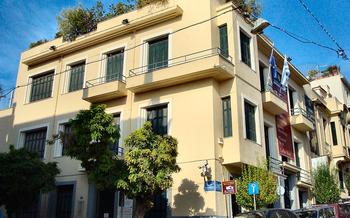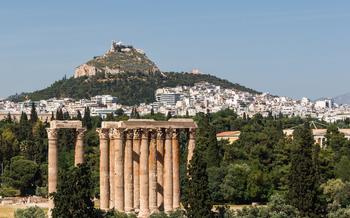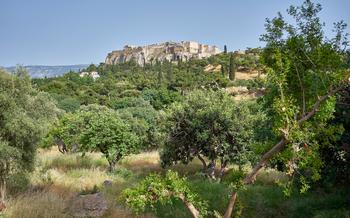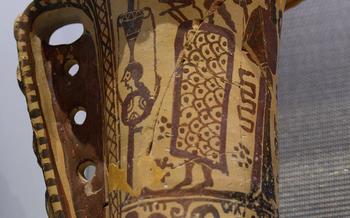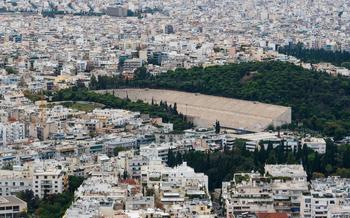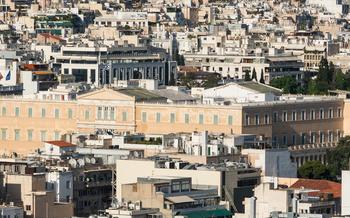
Museum of Illusions Athens
- Acropolis Museum
- Ancient Agora
- National Archaeological Museum
- Overview of the Collection
- Highlight Artifacts from Different Eras
- Advice for Navigating the Museum
- Temple of Zeus Olympios
- Panathenaic Stadium
- Benaki Museum: A Journey Through Greek History and Art
- Museum of Cycladic Art
- Byzantine and Christian Museum
- National Historical Museum
- War Museum: A Poignant Journey Through Greek Military History
- Jewish Museum of Greece
- Technopolis City of Athens
- Frissiras Museum: A Haven for Modern and Contemporary Greek Art
- Insider Tip:
Acropolis Museum
Nestled at the foot of the majestic Acropolis, the Acropolis Museum stands as a testament to the enduring legacy of ancient Greece. Inaugurated in 2009, this world-class museum houses an unparalleled collection of artifacts excavated from the sacred hill, offering visitors a profound journey into the artistic and cultural achievements of classical Athens.
The Acropolis Museum's architectural brilliance mirrors the grandeur of its exhibits. Its minimalist design, characterized by glass panels and natural light, creates a harmonious dialogue between contemporary aesthetics and timeless antiquities. As you step inside, prepare to be captivated by the sheer number and exquisite artistry of the sculptures, friezes, and votive offerings that adorn the museum's galleries.
Among the must-see exhibits are the Caryatid Porch Maidens, whose serene beauty and intricate details have captivated visitors for centuries. The Parthenon Marbles, a collection of sculptures that once graced the Parthenon temple, stand as a testament to the unparalleled craftsmanship of ancient Greek artists. The Erechtheion Caryatids, with their enigmatic expressions and flowing drapery, invite contemplation and admiration.
Ancient Agora
The Ancient Agora, situated in the heart of Athens, is a significant archaeological site and a testament to the city's glorious past. It served as the bustling center of ancient Athenian life, hosting political assemblies, commercial activities, and religious ceremonies. As you wander through the ruins of this ancient marketplace, you'll encounter fascinating structures that narrate the story of Athens' democratic roots and cultural heritage.
Among the must-see highlights of the Ancient Agora are the well-preserved Temple of Hephaestus, an architectural marvel dedicated to the patron god of metalworking. The Stoa of Attalos, a beautifully reconstructed colonnade, offers a glimpse into the commercial life of ancient Athens. The Altar of the Twelve Gods, dedicated to the Olympian deities, stands as a testament to the religious devotion of the Athenians.
To fully appreciate the significance of the Ancient Agora, it's recommended to join a guided tour. Knowledgeable guides will unravel the stories behind the ruins, bringing history to life and providing insights into the daily lives of ancient Athenians. Alternatively, you can explore the site at your own pace, using an audio guide or the informative signage provided throughout the area.
For an enriching visit, plan your trip during the early morning or late afternoon to avoid the midday heat. Wear comfortable shoes as you'll be doing a fair amount of walking on uneven surfaces. Don't forget your camera to capture the stunning views of the Acropolis and the surrounding ancient monuments.
National Archaeological Museum
The National Archaeological Museum in Athens houses one of the world's most extensive and impressive collections of ancient Greek artifacts. Its vast array of exhibits spans various eras, providing a comprehensive journey through the rich history and culture of ancient Greece.
Overview of the Collection
The museum's collection encompasses a diverse range of artifacts, including sculptures, pottery, jewelry, tools, and weapons. Highlights include the famous Minoan frescoes from Akrotiri, the Mycenaean gold masks from the Shaft Graves, and the Classical sculptures from the Parthenon.
Highlight Artifacts from Different Eras
The museum's collection is particularly renowned for its Cycladic figurines, which offer a glimpse into the enigmatic Cycladic civilization that flourished in the Aegean Sea from the 3rd millennium BC. Other notable exhibits include the Antikythera Mechanism, an ancient astronomical calculator, and the Marathon Boy, a bronze statue of a young athlete.
Advice for Navigating the Museum
To make the most of your visit, plan to spend at least two hours exploring the museum's vast collection. Audio guides are available for rent, providing insightful commentary on the exhibits. The museum also offers guided tours, which can be particularly helpful for those who want to delve deeper into the history and significance of the artifacts.
Temple of Zeus Olympios
The Temple of Zeus Olympios, a testament to ancient Greek architectural prowess, stands tall in the heart of Athens. Its construction began in the 6th century BC under the rule of Peisistratos and spanned several centuries, finally completed by the Roman emperor Hadrian in the 2nd century AD. This colossal temple, dedicated to the king of the gods, Zeus, was one of the largest and most impressive structures in the ancient world.
History and Architectural Features:
The temple's grandeur is evident in its massive dimensions, measuring 135 meters in length and 64 meters in width. It was adorned with 104 colossal Corinthian columns, each standing 17 meters tall and weighing over 60 tons. The interior of the temple housed a gigantic statue of Zeus, crafted from ivory and gold by the renowned sculptor Phidias, further enhancing its awe-inspiring presence.
Significance in Greek Mythology and Culture:
The Temple of Zeus Olympios held immense religious and cultural significance in ancient Greece. Zeus, the supreme deity of the Greek pantheon, was revered as the protector of the city of Athens. The temple served as a central site for religious ceremonies, festivals, and rituals honoring Zeus and other Olympian gods.
Suggestions for an Immersive Experience:
-
Explore the Temple Grounds: Wander through the sprawling archaeological site, taking in the sheer scale and magnificence of the temple ruins. Marvel at the remaining columns, which still convey the grandeur of this ancient marvel.
-
Visit the Temple of Olympian Zeus Museum: Located adjacent to the temple, this museum houses a collection of artifacts and sculptures discovered during excavations, providing further insights into the history and significance of the site.
-
Admire the Panoramic Views: Climb to the top of the Acropolis Hill, where you can capture breathtaking views of the Temple of Zeus Olympios, the city of Athens, and the surrounding landscape.
Panathenaic Stadium
The Panathenaic Stadium, also known as the Kallimarmaro or "the Beautiful in Marble," stands as a testament to Athens' rich sporting history. Built in the 4th century BC, it served as the venue for the ancient Olympic Games from 566 to 393 AD. The stadium was reconstructed in marble in the late 19th century to host the first modern Olympic Games in 189
Historical Significance
The revival of the Olympic Games in the late 19th century was a significant event that aimed to revive the spirit of ancient Greece. The Panathenaic Stadium, with its rich history and symbolism, was chosen as the venue for the first modern games. It was an emotional and symbolic moment for the Greek people, who saw the Olympic Games as a way to reconnect with their ancient heritage.
Architectural Features and Renovations
The Panathenaic Stadium is a horseshoe-shaped stadium built entirely of white marble. It has a capacity of over 50,000 spectators and features a running track, a field for various sports, and a curved seating area. The stadium underwent extensive renovations in the late 19th century to prepare it for the first modern Olympic Games. These renovations included the addition of marble seating, the reconstruction of the track, and the installation of modern facilities.
Tips for Exploring the Stadium
-
Book a guided tour: A guided tour of the Panathenaic Stadium is an excellent way to learn about its history, architecture, and significance. Tours are available in multiple languages and provide insights into the stadium's role in ancient and modern Olympic Games.
-
Explore the stadium independently: If you prefer to explore at your own pace, you can purchase a ticket and wander around the stadium. Be sure to take in the views from the top rows of the seating area, which offer panoramic vistas of Athens.
-
Attend an event: The Panathenaic Stadium occasionally hosts sporting events, concerts, and cultural performances. Attending an event is a great way to experience the stadium's unique atmosphere and feel the energy of the crowd.
Benaki Museum: A Journey Through Greek History and Art
Nestled in the heart of Athens, the Benaki Museum stands as a testament to the rich cultural heritage of Greece. Founded in 1930 by Antonis Benakis, a prominent collector and philanthropist, the museum houses a diverse collection that spans various periods of Greek history and art, from prehistoric times to the present day.
The permanent collection boasts an impressive array of artifacts, including ancient sculptures, Byzantine icons, Ottoman-era textiles, and paintings by renowned Greek artists. Visitors can trace the evolution of Greek art and culture through the centuries, gaining insights into the country's diverse artistic traditions.
Among the highlights of the permanent collection are the exquisite Cycladic figurines, dating back to the 3rd millennium BC. These enigmatic marble sculptures, with their simplified forms and serene expressions, offer a glimpse into the early artistic expressions of the Aegean region.
The museum also houses a significant collection of Islamic art, showcasing the influence of the Ottoman Empire on Greek culture. Visitors can admire intricate carpets, ceramics, and metalwork, as well as manuscripts and illuminated Qur'ans.
Temporary exhibitions at the Benaki Museum further enrich the visitor experience, presenting a diverse range of themes and artistic movements. From contemporary art installations to historical retrospectives, these exhibitions offer a dynamic and ever-changing perspective on Greek culture.
To fully appreciate the Benaki Museum's vast collection, it's recommended to allocate at least two to three hours for your visit. The museum's friendly and knowledgeable staff is always on hand to provide guidance and answer any questions you may have.
With its diverse and captivating collection, the Benaki Museum is a must-visit for anyone interested in exploring the rich cultural heritage of Greece.
Museum of Cycladic Art
Nestled in the heart of Athens, the Museum of Cycladic Art stands as a testament to the enigmatic Cycladic civilization that flourished in the Aegean Sea from the 3rd millennium BC to the early 2nd millennium BC. Within its walls, visitors embark on a journey through time, discovering a treasure trove of Cycladic figurines, sculptures, pottery, and artifacts that offer a glimpse into the beliefs, rituals, and daily lives of this ancient society.
The museum's collection boasts over 3,000 artifacts, each a masterpiece of Cycladic artistry. Among the highlights are the iconic Cycladic figurines, characterized by their distinctive minimalist forms and enigmatic expressions. These captivating sculptures, often depicting female figures with folded arms and schematic facial features, invite viewers to contemplate the spiritual and symbolic significance they held for the Cycladic people.
Beyond the figurines, the museum showcases an array of other Cycladic artifacts, including intricately decorated pottery, marble vessels, and tools. These objects provide valuable insights into the technological advancements, economic activities, and artistic traditions of the Cycladic civilization.
To fully appreciate the significance of the Cycladic collection, visitors are encouraged to delve into the museum's educational exhibits and resources. Interactive displays, informative panels, and multimedia presentations shed light on the archaeological discoveries, cultural context, and ongoing research surrounding the Cycladic civilization.
By immersing themselves in the Museum of Cycladic Art, visitors gain a profound understanding of this ancient civilization that left an indelible mark on the cultural heritage of Greece and the broader Mediterranean region.
Byzantine and Christian Museum
The Byzantine and Christian Museum houses a stunning collection of artifacts that tell the story of the Byzantine Empire and its influence on Greek culture. The museum's exhibits span from the 4th to the 20th century, providing a comprehensive overview of Byzantine art and its evolution.
Key Artifacts and Their Historical Significance
Among the museum's highlights is the 6th-century mosaic of the Virgin Mary and Child, which is considered one of the finest examples of Byzantine iconography. Other must-see exhibits include the 11th-century mosaic of the Dodekaorton, which depicts the twelve major feasts of the Orthodox Christian calendar, and the 14th-century frescoes from the Church of the Holy Apostles, which offer a glimpse into the vibrant world of Byzantine painting.
Tips for a Meaningful Visit
To make the most of your visit to the Byzantine and Christian Museum, take some time to learn about the history of the Byzantine Empire before you go. This will help you appreciate the significance of the artifacts on display. The museum also offers guided tours, which can provide valuable insights into the collection. Finally, don't forget to visit the museum's gift shop, which offers a wide range of books, souvenirs, and reproductions of Byzantine art.
National Historical Museum
The National Historical Museum takes you on a compelling journey through Greece's rich and tumultuous history, spanning the Middle Ages to the modern era. Located in the heart of Athens, this museum houses a vast collection of artifacts, documents, and artworks that vividly narrate the country's evolution.
Must-see exhibits include the impressive collection of Byzantine icons, offering a glimpse into the religious and artistic heritage of the period. The museum also showcases significant artifacts from the Greek War of Independence, including personal belongings of prominent figures like Theodoros Kolokotronis and Ioannis Kapodistrias.
To make the most of your visit, consider joining a guided tour to gain insights into the historical context and significance of the exhibits. The museum also offers educational programs and workshops throughout the year, providing an opportunity to delve deeper into specific aspects of Greek history.
War Museum: A Poignant Journey Through Greek Military History
History and Significance
The War Museum in Athens stands as a powerful testament to Greece's rich military heritage, spanning centuries of conflicts and struggles. Established in 1975, the museum offers a poignant journey through Greece's involvement in the Balkan Wars, World War I, World War II, and other significant military engagements.
Exhibits and Artifacts
The museum's collection boasts an array of captivating exhibits, including uniforms, weapons, military equipment, and personal belongings of Greek soldiers. Visitors can explore interactive displays, immerse themselves in multimedia presentations, and witness authentic artifacts that bring the stories of Greek heroism and sacrifice to life.
Personal Stories
Beyond the historical accounts, the War Museum places a strong emphasis on the human experiences of those who served in Greece's armed forces. Through compelling narratives and personal testimonies, visitors gain insights into the sacrifices, bravery, and resilience of Greek soldiers throughout history.
Tips for an Enriching Visit
- Allow ample time to explore the museum's extensive collection, as each exhibit offers valuable historical context and insights.
- Take advantage of the museum's guided tours, available in multiple languages, for a deeper understanding of the exhibits and their significance.
- Engage with the interactive displays and multimedia presentations to immerse yourself in the stories of Greek soldiers and their experiences.
- Reflect on the personal testimonies and sacrifices of those who fought for Greece's freedom and sovereignty.
- Visit the museum's temporary exhibitions, which often showcase specific conflicts or themes related to Greek military history.
Jewish Museum of Greece
The Jewish Museum of Greece is an emblem of the rich and often untold history of the Jewish community in the country. Situated in the heart of Athens' former Jewish quarter, the museum chronicles the presence and contributions of Jews in Greece from antiquity to the present day. Through an array of artifacts, documents, and multimedia presentations, visitors are transported on a journey through the vibrant tapestry of Jewish life in Greece. From the establishment of the first Jewish communities in the 3rd century BC to their pivotal role in the arts, commerce, and intellectual pursuits, the museum sheds light on the deep roots and enduring legacy of Greek Jewry.
Highlights of the Museum's Collection:
-
Ancient inscriptions and artifacts, including menorahs, coins, and pottery shards, testify to the presence of Jews in Greece during the Hellenistic and Roman periods.
-
Medieval manuscripts, ceremonial objects, and textiles illustrate the flourishing of Jewish culture and religious practices in the Byzantine era.
-
Historical documents and photographs narrate the experiences of Greek Jews during the Ottoman Empire and the modern Greek state, including their contributions to the country's economic, social, and cultural life.
-
A poignant section of the museum is dedicated to the Holocaust, commemorating the tragic loss of Greek Jews during World War II. Artifacts, personal testimonies, and a memorial wall pay tribute to the victims and their families.
Recommendations for a Deeper Understanding of Jewish Heritage:
-
To fully immerse yourself in the museum's exhibits, consider booking a guided tour led by an expert on Jewish history and culture. Guided tours are available in multiple languages, providing in-depth insights and anecdotes that enrich the visitor experience.
-
Delve into the museum's extensive library, which houses a wealth of books, manuscripts, and documents related to Jewish studies. Researchers and history enthusiasts can find valuable resources for their academic pursuits.
-
Participate in the museum's educational programs and workshops, which offer a hands-on approach to learning about Jewish traditions, customs, and holidays. These programs are designed to engage visitors of all ages and backgrounds.
-
The museum hosts regular cultural events, film screenings, and lectures that explore various aspects of Jewish life and history. Attending these events provides an opportunity to engage with scholars, artists, and community members, fostering a deeper understanding of Jewish heritage.
Technopolis City of Athens
A former gasworks, now transformed into a vibrant cultural and educational center, Technopolis City of Athens stands as a testament to the city's ability to breathe new life into its industrial past. Once a hub of energy production, Technopolis now pulsates with creativity and innovation, hosting a diverse array of exhibitions, events, and workshops.
Step into this captivating realm and immerse yourself in a world where art, science, and technology converge. Explore the thought-provoking exhibitions that delve into contemporary issues, showcasing the works of both established and emerging Greek and international artists. Immerse yourself in the fascinating history of science and technology through interactive displays and hands-on exhibits, providing insights into the minds of great thinkers and the evolution of groundbreaking inventions.
Technopolis is not merely a passive observer of the past; it actively engages with the present and embraces the future. Attend captivating performances, screenings, and concerts that showcase the talents of local and international artists. Engage in educational workshops and lectures that stimulate your intellect and broaden your horizons.
As you wander through the beautifully restored industrial buildings, don't miss the chance to savor delicious Mediterranean cuisine at one of the on-site restaurants. Relax and unwind in the tranquil courtyard, surrounded by lush greenery and the gentle murmur of water features.
Technopolis City of Athens is a microcosm of modern Athens, where history and innovation intertwine to create a vibrant and dynamic cultural landscape. Whether you're an art enthusiast, a science buff, or simply seeking a unique and engaging experience, Technopolis has something to offer everyone.
Frissiras Museum: A Haven for Modern and Contemporary Greek Art
The Frissiras Museum, nestled in the heart of Athens' charming Plaka neighborhood, is a treasure trove of modern and contemporary Greek art. Founded in 2000 by Vlassis Frissiras, a renowned collector and art enthusiast, the museum showcases a diverse collection of paintings, sculptures, drawings, and mixed media works by established and emerging Greek artists.
The museum's collection spans the 20th and 21st centuries, offering a comprehensive overview of the evolution of Greek art during this period. Visitors can admire the bold colors and abstract forms of Yannis Tsarouchis, the surrealist landscapes of Nikos Engonopoulos, and the haunting sculptures of George Zongolopoulos. Works by contemporary artists, such as Jannis Kounellis, Maria Loizidou, and Stefanos Tsivopoulos, provide a glimpse into the vibrant and innovative contemporary Greek art scene.
The Frissiras Museum is not just a place to view art; it is also a platform for cultural exchange and education. The museum regularly hosts temporary exhibitions, workshops, and lectures, providing visitors with opportunities to engage with artists, learn about different art movements, and gain a deeper appreciation for Greek culture.
For those interested in delving into the world of modern and contemporary Greek art, the Frissiras Museum is a must-visit. With its carefully curated collection, thought-provoking exhibitions, and vibrant atmosphere, the museum offers a unique and enriching experience for art enthusiasts and casual visitors alike.
Insider Tip:
To make the most of your museum visits in Athens, consider purchasing a combined ticket that grants you access to multiple museums at a discounted price. This can save you both money and time, especially if you plan to visit several museums during your stay. Additionally, be sure to check the websites of individual museums for information on special exhibitions and events. These temporary exhibits often showcase unique artifacts or offer a fresh perspective on the museum's collection. Finally, if possible, plan your visit during the off-season (typically from November to March) to avoid the crowds and enjoy a more relaxed museum experience.


